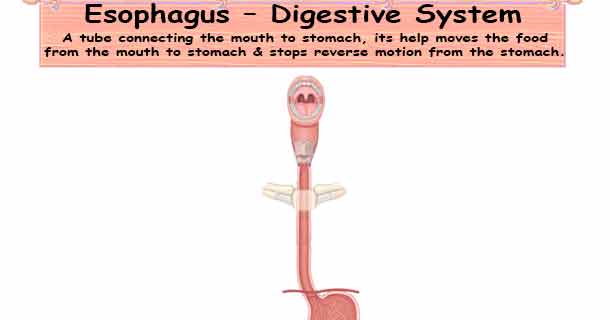What is Esophagus? A magic tube connecting the mouth to stomach, its help moves the food from the mouth to stomach and stops reverse motion from the stomach.
Esophagus – Digestive System
Upper esophageal sphincter is a muscle bundle at the beginning of the esophagus. This muscle is in use when breathing, eating, belching, and vomiting. Immediately, when swallowing the upper esophageal sphincter opens to allow the bolus (masticated food) to pass into the esophagus. As well as it prevents the backflow from the esophagus into the pharynx. It also makes the sound of eructation.
Esophagus (or oesophagus or gullet) is a muscular tube connecting the throat (pharynx) with the stomach. During swallowing food travels from the mouth through the pharynx into the esophagus and to the stomach by peristaltic contraction of the esophagus. Esophagus is a tube of about 25 to 30 cm long connecting the mouth to the stomach; food takes only 7 to 10 seconds to travel through the esophagus. When the body is in the upright position, even then, liquids can travel through esophagus and reaches the stomach due to this peristaltic contraction.
We do normally not feel the presence of the esophagus, but sometimes we feel its presents when we swallow anything too large, or try to drink very hot or cold.
The esophageal glands are small exocrine glands located in sub-mucosa layer of the esophagus which secrets mucous. Mucus secretion helps to lubricate the bolus (masticated foods from mouth) and allow it to pass the esophagus smoothly.
Lower esophageal sphincter (also called as Cardiac sphincter, Gastro-esophageal junction, Cardiac valve, or Cardia) is a muscular bundle at the lower end of the esophagus, just before the stomach. It prevents food from passing back to the esophagus once entered into the stomach. These muscles are not under voluntary control that maintains constriction and relaxes of passage by physiological function.
Esophagus – Digestive Process
There is no digestion is carryout by the esophagus. Instead, the enzymes that present in the saliva continue its breakdown until it reaches the stomach. These enzymes are deactivating by the hydrochloric acid present in the stomach.

